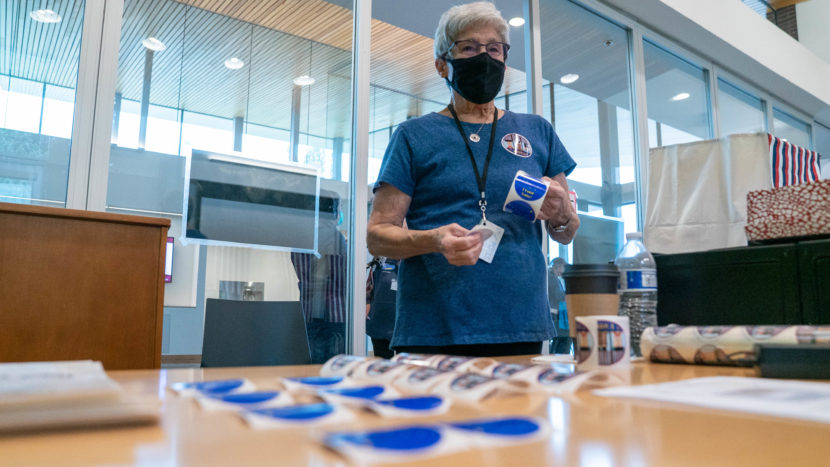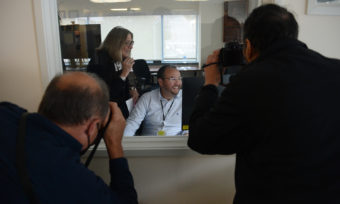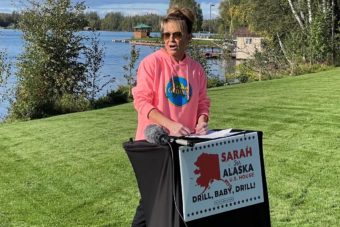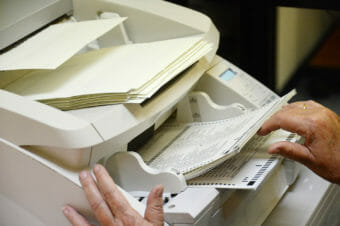
Alaska’s primary on Tuesday hasn’t narrowed the field of candidates for state offices so much as given a glimpse of the support they have heading toward the November general election.
In fact, with the top four advancing in each race, only one candidate in the legislative primaries was cut after finishing fifth, because it was the only race with more than four candidates.
As Alaska Beacon reporter James Brooks points out, the votes tallied in Tuesday’s primary mostly amount to a state-sponsored poll with a nice, big sample size.
And while candidates can adjust in the next couple months and the political landscape could change, Brooks says the primary election is still a good indicator of what’s to come, especially in the governor’s race, which shows incumbent Gov. Mike Dunleavy solidly in the lead with about 42% of the vote.
Listen:
The following transcript has been lightly edited for clarity.
James Brooks: Closest to (Dunleavy) are independent and former Gov. Bill Walker and the Democratic candidate, a former Anchorage legislator, Les Gara. Both of them have around 22%. And since we have a top-four primary, the person that’s looking likely to fill the fourth spot, is Kenai Peninsula Borough Mayor Charlie Pierce, who’s running about 6.8%. So trailing all three, but not out of the running and headed on to November himself.
Casey Grove: Well, some of us will remember that, before Dunleavy was elected, there was the situation where Byron Mallott won the Democratic nomination, Bill Walker was running as an independent, there were some court battles to kind of figure this out, but eventually Walker and Mallott were allowed to run together, and then they won. So I guess, I wonder, is there any kind of discussion of a similar situation happening here with Walker and Gara? Or are people talking about one or the other dropping out maybe to give the other one a better chance?
James Brooks: I haven’t heard of any talk like that yet. And I think with ranked choice voting, there’s less incentive for that to happen. Because, let’s say, Dunleavy’s not at 50%, even after the Pierce campaign is eliminated, again, in this hypothetical, where Pierce’s in fourth in November.
So let’s say even with Pierce’s votes, Dunleavy, he’s not at 50%, well you go to the next round of knockouts, so if Gara finishes below Walker, most of Gara’s voters are probably going to go for Walker, and there’s a chance that’s enough to put Walker over the top.
And again, we won’t know that because Gara and Walker are very close together at this point, enough that the results between now and November are almost certainly going to change one way or another.
Casey Grove: Yeah, no doubt. And tell me more about that. I mean, of some of the political observers that you’ve talked to, I guess, what significance do they see in the primary numbers? You know, in terms of how accurate those may even be as a poll?
James Brooks: Right. The more people who participate in the August primary, the better an analogy it’ll be for November. Right now, turnout’s running a bit above 26% of registered voters. Now, you look at 26%, and that’s that doesn’t seem like very much. But it’s the highest turnout we’ve seen in the primary since 2014. And that’s when you start to think that, well, maybe August is a good map for what might happen in November. And the question then becomes: What will these candidates and campaigns do to change their positions between now and then?
Casey Grove: Yeah, that’ll be interesting to see how people react to those numbers, how the candidates react to those numbers. And I guess, I mean, at the same time, a pollster would be pretty happy with the sample size, I think.
James Brooks: Right. And I think the pollsters should be pretty happy with themselves, anyway. The results of the primary were pretty darn close to what the public and private polling was indicating going into August. The general order is spot on. And the same with the other statewide races as well.
Casey Grove: Yeah, that’s what I want to talk to you about next. And I think maybe normally we would save this question for later, but I thought it was interesting that your story about this in the Alaska Beacon, you started off with the one person that was actually eliminated in the pick-one primary, where only the top four are going to advance. But there’s this one guy that got eliminated, right?
James Brooks: Yeah. There’s almost 200 candidates running for legislative offices this year. Fifty-nine races in total, 19 for the Senate, 40 for the state House. And in all of those 59 races, all but one had four or fewer candidates. And since it’s a top-four primary, nobody gets eliminated.
The only place that had five candidates was House District 35, which is up in Fairbanks, western Fairbanks, covering the university and some areas around it. And in that place, Alaska Constitution Party candidate Kieran Brown is on pace to be eliminated. And then we’ll go from there into November across the state.
Casey Grove: Of those legislative races that you’re looking at, were there, or I should say, are there, still some close races?
James Brooks: Yes. One of the things that I’ve been looking for the most in the legislative races this year is the possibility of a coalition majority next year in the state Senate. Will there be enough Democrats, independents and moderate Republicans elected that they could take control of the Senate, have a majority of the 20 seats in the Senate, in the same way that the House has been controlled by a coalition majority for the past few years?
And so what I’m seeing is moderate Republicans are doing well against more conservative Republicans across the state. I’ve seen a lot of Democrats doing well and some very close races that will end up potentially being decisive in November.
For example, in West Anchorage, you’ve got an incumbent House Rep. Matt Claman, who’s challenging a longtime incumbent Republican state Sen. Mia Costello, in a district that was redistricted from a Republican-leaning one into a Democratic-leaning one. Now, on election night, the results are leaning Claman slightly. Will that change by November? I don’t know. But it looks close either way.
And then up in Fairbanks, you’ve got an incumbent Democratic Sen. Scott Kawasaki, who’s being challenged by the Republican Mayor of Fairbanks Jim Matherly. That race also looks like it’ll be close in November, largely because it was close here this week.



